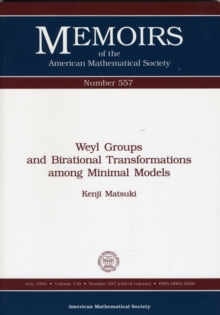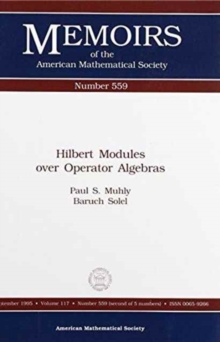
Geometric Pressure for Multimodal Maps of the Interval Paperback / softback
by Feliks Przytycki, Juan Rivera-Letelier
Part of the Memoirs of the American Mathematical Society series
Paperback / softback
Description
This paper is an interval dynamics counterpart of three theories founded earlier by the authors, S.
Smirnov and others in the setting of the iteration of rational maps on the Riemann sphere: the equivalence of several notions of non-uniform hyperbolicity, Geometric Pressure, and Nice Inducing Schemes methods leading to results in thermodynamical formalism. The authors work in a setting of generalized multimodal maps, that is, smooth maps $f$ of a finite union of compact intervals $\widehat I$ in $\mathbb{R}$ into $\mathbb{R}$ with non-flat critical points, such that on its maximal forward invariant set $K$ the map $f$ is topologically transitive and has positive topological entropy.
They prove that several notions of non-uniform hyperbolicity of $f|_K$ are equivalent (including uniform hyperbolicity on periodic orbits, TCE & all periodic orbits in $K$ hyperbolic repelling, Lyapunov hyperbolicity, and exponential shrinking of pull-backs).
They prove that several definitions of geometric pressure $P(t)$, that is pressure for the map $f|_K$ and the potential $-t\log |f'|$, give the same value (including pressure on periodic orbits, ``tree'' pressure, variational pressures and conformal pressure).
Finally they prove that, provided all periodic orbits in $K$ are hyperbolic repelling, the function $P(t)$ is real analytic for $t$ between the ``condensation'' and ``freezing'' parameters and that for each such $t$ there exists unique equilibrium (and conformal) measure satisfying strong statistical properties.
Information
-
Available to Order - This title is available to order, with delivery expected within 2 weeks
- Format:Paperback / softback
- Pages:81 pages
- Publisher:American Mathematical Society
- Publication Date:30/07/2019
- Category:
- ISBN:9781470435677
Other Formats
- PDF from £72.90
Information
-
Available to Order - This title is available to order, with delivery expected within 2 weeks
- Format:Paperback / softback
- Pages:81 pages
- Publisher:American Mathematical Society
- Publication Date:30/07/2019
- Category:
- ISBN:9781470435677









